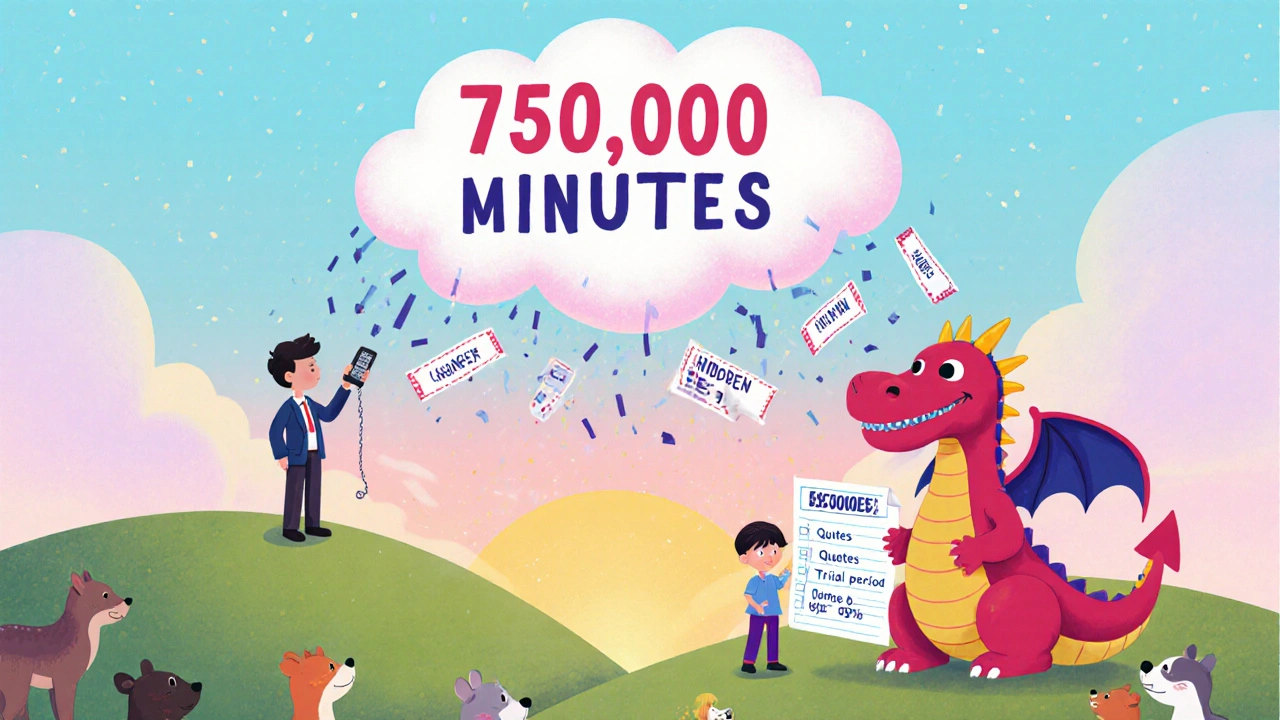Why VoIP Volume Discounts Matter More Than You Think
If you’re paying retail rates for VoIP calls, you’re leaving money on the table. Businesses that negotiate volume discounts and commit to longer terms typically save 20-40% on their monthly phone bills. That’s not a small perk-it’s a major cost reduction. A company with 100 employees making 500,000 minutes of calls per month could save over $15,000 a year just by switching from a flat-rate plan to a negotiated volume discount. And it’s not just about calling more-it’s about calling smarter.
VoIP providers don’t give discounts out of generosity. They want predictable traffic. The more minutes you commit to, the more they can plan their network capacity, reduce per-minute costs, and lock in long-term revenue. In return, you get lower rates. It’s a simple trade: your volume for their discount. But getting that deal isn’t automatic. You need to know how to ask for it, when to push back, and what traps to avoid.
How Volume Discounts Actually Work (The Real Numbers)
Not all volume discounts are created equal. Most providers use tiered pricing, where your rate drops as your monthly call volume climbs. Here’s what you’re likely to see:
- 10,000-49,999 minutes/month: No discount (standard rate)
- 50,000-99,999 minutes/month: 5-8% discount
- 100,000-499,999 minutes/month: 10-15% discount
- 500,000+ minutes/month: 20-25% discount
These thresholds aren’t arbitrary. They’re based on where providers hit economies of scale. Below 10,000 minutes, most providers won’t even entertain a discount. That’s why small businesses with under 20 employees often pay full price-they don’t meet the minimum.
But here’s the catch: volume isn’t just about total minutes. Route matters too. Calls to the U.S. and Canada cost as little as $0.005 per minute. Calls to India or Nigeria? $0.03-$0.05 per minute. If you’re making a lot of international calls, your discount percentage might look good-but your actual savings could be lower than expected. Always ask for per-minute rates by destination, not just an average.
Commitment Terms: The Long Game
Volume discounts come with strings attached: commitment terms. These are contracts that lock you in for a set time-usually 6, 12, 24, or 36 months. The longer the term, the bigger the discount. On average:
- 6-month contract: 0-3% discount
- 12-month contract: 10-15% discount
- 24-month contract: 15-20% discount
- 36-month contract: 18-25% discount
Why does this happen? Providers invest in infrastructure and sales resources to onboard you. They need assurance you won’t leave after a month. In return, they give you a better rate. But don’t be fooled by the lure of a 36-month deal. If your business grows or your call patterns change, you could be stuck with outdated pricing or overpaying for unused capacity.
Smart negotiators ask for flexibility:
- Annual volume reviews to adjust rates based on actual usage
- Exit clauses if service quality drops below 99.9% uptime
- Grace periods to scale up without penalty
One company in Chicago cut its VoIP bill by 22% by signing an 18-month contract with a 75,000-minute monthly minimum. They built in a clause that allowed them to increase volume to 100,000 minutes without renegotiating-and the provider honored it because they knew the company’s growth trajectory.
Flat Rate vs. Tiered vs. Negotiated: Which One Wins?
There are three main VoIP pricing models. Here’s how they stack up:
| Model | Best For | Pros | Cons |
|---|---|---|---|
| Flat Rate | Small teams, low volume | Simple, no tracking needed | 15-25% more expensive than tiered for high users |
| Tiered | Stable, predictable usage | Clear discounts at volume thresholds | 32% of users go over budget during peak months |
| Negotiated | 100k+ minutes/month, enterprise | Custom rates, bundled services, SLA flexibility | Requires strong negotiation, minimum 100k minutes |
Flat rate sounds easy-but if you’re making more than 50,000 minutes a month, you’re paying too much. Tiered pricing is the sweet spot for most growing businesses. But if you’re at 200,000+ minutes and have multiple departments using VoIP, negotiated pricing is your best bet. That’s where you bundle hardware, SIP trunking, and call recording into one contract-and get a deeper discount.

How to Negotiate Like a Pro
Negotiation isn’t about yelling louder. It’s about preparation. Here’s how to do it right:
- Track your usage for at least 3 months. Know your peak hours, top destinations, and monthly volume. Use your current provider’s reports or a third-party tool like CallRail or Dialpad analytics.
- Get 3+ quotes. Don’t talk to just one provider. Use platforms like Twilio, Bandwidth, and Vonage. Even if you plan to stick with your current vendor, competition forces them to improve their offer.
- Highlight your potential. Tell them you’re planning to grow to 750,000 minutes in 12 months. Providers will give you a better rate today if they see future volume.
- Bundle services. Ask if they offer discounts for bundling VoIP with UCaaS, fax-to-email, or call center software. One business saved 18% by adding CRM integration to their VoIP contract.
- Use prepayment. Pay quarterly or annually for an extra 5-10% off. It’s a win-win: they get cash flow, you get savings.
- Test before you sign. Demand a 30-90 day trial. Monitor call quality, dropped calls, and support response time. 78% of successful negotiators use this step.
Don’t be afraid to walk away. If a provider won’t budge on volume discounts, they’re not worth your time. The market is competitive. There are dozens of providers who will.
Watch Out for Hidden Costs
A 25% discount sounds amazing-until you get hit with $200 in hidden fees. Common traps:
- Setup fees ($50-$200)
- Per-line charges for extensions
- Minimum usage fees if you go under your commitment
- Early termination fees (often 50-100% of remaining contract value)
- Call recording or analytics add-ons
According to Trustpilot, 28% of users say hidden fees erased their discount savings. Always ask for a full line-item breakdown before signing. Include every fee in your cost-per-minute calculation.
Quality Isn’t Optional-It’s Part of the Deal
Lowest price doesn’t mean best value. A provider offering 30% off but with 99.5% uptime is worse than one charging 15% less with 99.99% uptime. Why? Because dropped calls cost more in lost sales and customer trust than extra monthly fees.
Insist on a Service Level Agreement (SLA) that guarantees:
- 99.9% minimum uptime
- 2-hour response time for critical outages
- Refunds for downtime exceeding 0.1%
Businesses with formal SLAs report 35% fewer disruptions and 40% higher satisfaction with their discount terms (G2 Crowd, Q1 2025). Don’t accept vague promises like “we aim for high reliability.” Demand numbers.

What the Experts Say
Industry analysts agree: the biggest mistake businesses make is negotiating too early. You need data before you walk into a meeting. Jayanth Angl from Info-Tech Research Group says: “Discounts are higher if you buy all your IP phone services from one vendor.” That means bundling your phones, call routing, and support under one contract.
Mark Johnson, CEO of Progressive Telecom, adds: “Understand your peak hours. Shifting non-critical calls to off-peak times can save 25-30%.” If your team makes a lot of outbound sales calls at 9 a.m., try scheduling internal meetings during lunch. Use call analytics to find low-traffic windows and shift what you can.
Who Wins and Who Loses
Enterprise companies with 50+ employees save an average of $18,500 per year per 100 users. That’s because they have the volume and the resources to negotiate. Small businesses? Only 43% successfully get volume discounts. Why? They don’t track usage. They don’t shop around. They accept the first quote.
But the gap is closing. Tools like AI-driven call analytics are making it easier for small teams to understand their patterns. WebRTC is lowering infrastructure costs, which will trickle down to better rates. In 2025, even a team of 10 can get a 10-15% discount-if they know how to ask.
What’s Next for VoIP Pricing
The market is shifting. The top 10 providers now control 65% of wholesale VoIP traffic. That means less competition among small players-but more pressure on big ones to offer better deals to keep customers. Expect:
- More standardized volume tiers across providers
- AI tools that auto-optimize routes and predict usage
- Dynamic pricing based on real-time network congestion
- Greater transparency in billing and SLAs
By 2026, businesses that don’t use analytics to guide their VoIP negotiations will be paying more than those who do. The future belongs to those who treat VoIP as a strategic cost center-not just a utility.
